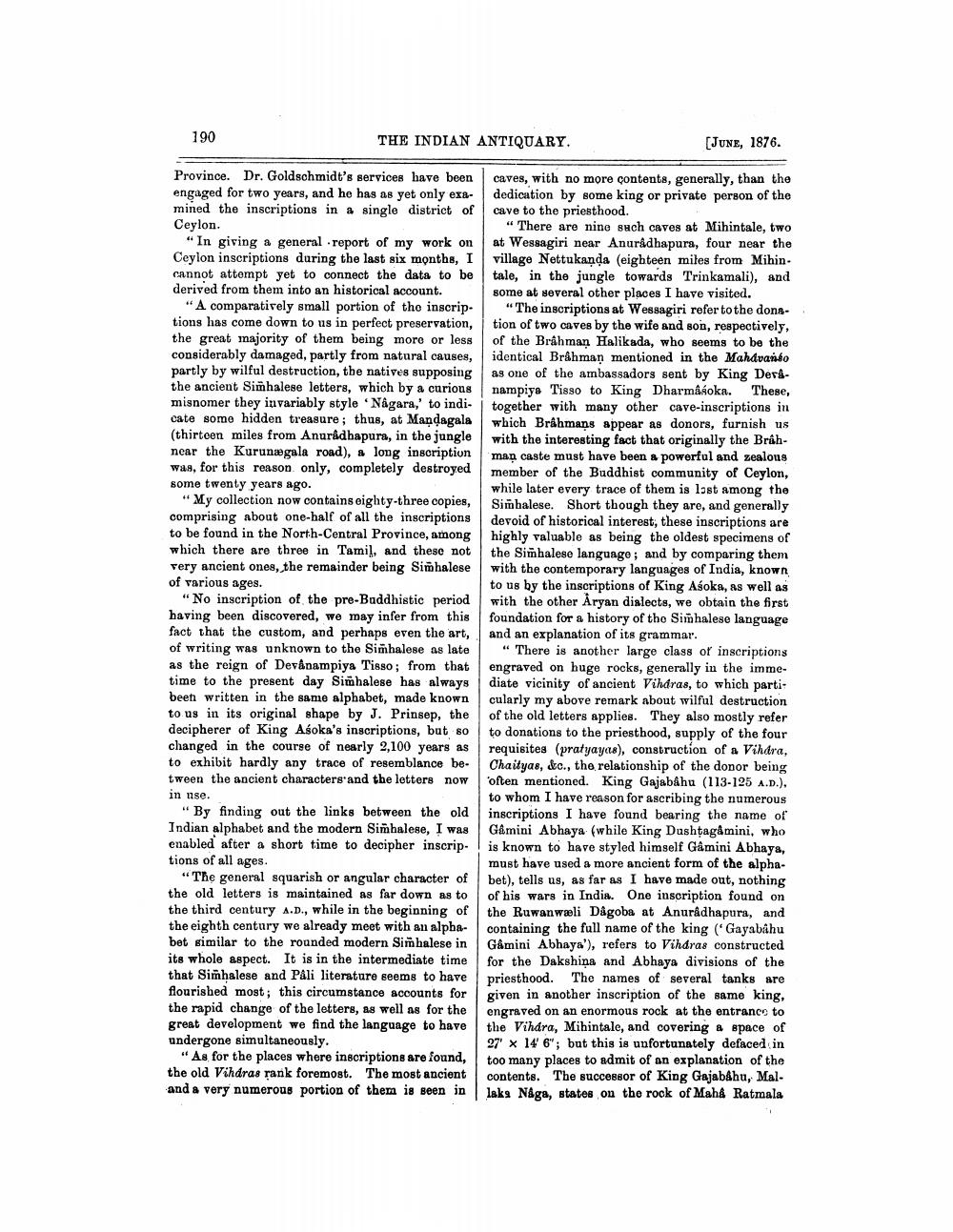________________
190
THE INDIAN ANTIQUARY.
[JUNE, 1876.
Province. Dr. Goldschmidt's services have been caves, with no more contents, generally, than the engaged for two years, and he has as yet only ex&- dedication by some king or private person of the mined the inscriptions in a single district of cave to the priesthood. Ceylon.
"There are nine such caves at Mihintale, two "In giving a general report of my work on at Wessagiri near Anuradhapura, four near the Ceylon inscriptions during the last six months, I village Nettukanda (eighteen miles from Mihin. cannot attempt yet to connect the data to be tale, in the jungle towards Trinkamali), and derived from them into an historical account. some at several other places I have visited.
"A comparatively small portion of tho inscrip- "The inscriptions at Wessagiri refer to the donations has come down to us in perfect preservation, tion of two caves by the wife and son, respectively, the great majority of them being more or less of the Brahman Halikada, who seems to be the considerably damaged, partly from natural causes, identical Brahman mentioned in the Mahavano partly by wilful destruction, the natives supposing as one of the ambassadors sent by King Derathe ancient Simhalese letters, which by a curions nampiya Tisso to King Dharmasoka. These, misnomer they invariably style "Någara,' to indi- together with many other cave-inscriptions in cate somo hidden treasure; thus, at Mandagala which Bráhmans appear as donors, furnish us (thirteen miles from Anuradhapura, in the jungle with the interesting fact that originally the Brahnear the Kurunægala road), a long inscription man caste must have been a powerful and zealous was, for this reason only, completely destroyed member of the Buddhist community of Ceylon, some twenty years ago.
while later every trace of them is last among the "My collection now contains eighty-three copies, Simbalese. Short though they are, and generally comprising about one-half of all the inscriptions devoid of historical interest, there inscrintions are to be found in the North-Central Province, among highly valuable as being the oldest specimens of which there are three in Tamil, and these not the Simhalese language, and by comparing them very ancient ones, the remainder being Simhalese with the contemporary languages of India, known of various ages.
to us by the inscriptions of King Asoka, as well as "No inscription of the pre-Buddhistic period with the other Aryan dialects, we obtain the first having been discovered, we may infer from this foundation for a history of tho Sinhalese language fact that the custom, and perhaps even the art, and an explanation of its grammar. of writing was unknown to the Sinhalese as late "There is another large class or inscriptions as the reign of Devånampiya Tisso; from that engraved on huge rocks, generally in the immetime to the present day Simhalese has always diate vicinity of ancient Vihdras, to which partibeen written in the same alphabet, made known cularly my above remark about wilful destruction to us in its original shape by J. Prinsep, the of the old letters applies. They also mostly refer decipherer of King Asoka's inscriptions, but so to donations to the priesthood, supply of the four changed in the course of nearly 2,100 years as requisites (pratyayas), construction of a Vihdra, to exhibit hardly any trace of resemblance be- Chaityas, &c., the relationship of the donor being tween the ancient characters and the lettere now often mentioned. King Gajab&hu (113-125 A.D.), in use.
to whom I have reason for ascribing the numerous "By finding out the links between the old inscriptions I have found bearing the name of Indian alphabet and the modern Simhalese, I was Gêmini Abhaya (while King Dushtagamini, who enabled after a short time to decipher inscripcis known to have styled himself Gâmini Abhaya, tions of all ages.
must have used a more ancient form of the alpha"The general squarish or angular character of bet), tells us, as far as I have made out, nothing the old letters is maintained as far down as to of his wars in India. One inscription found on the third century A.D., while in the beginning of the Ruwanwali Dagoba at Anuradhapura, and the eighth century we already meet with an alpha- containing the full name of the king ("Gayabahu bet similar to the rounded modern Simhalese in Gåmini Abhaya'), refers to Vihdras constructed its whole aspect. It is in the intermediate time for the Dakshina and Abhaya divisions of the that Simhalese and Páli literature seems to have priesthood. The names of several tanks are flourished most; this circumstance accounts for given in another inscription of the same king, the rapid change of the letters, as well as for the engraved on an enormous rock at the entrance to great development we find the language to have the Vihara, Mihintale, and covering space of undergone simultaneously.
27' x 14 6"; but this is unfortunately defaced in "As for the places where inscriptions are found, too many places to admit of an explanation of the the old Vihdras rank foremost. The most ancient contents. The successor of King Gajab&hu, Mal. and a very numerous portion of them is seen in laka Naga, states on the rock of Maha Ratmala




